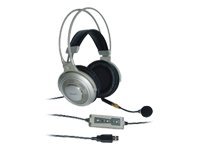The sound quality can be affected by many factors. When it comes to frequency range, a wider range will allow more detail to be heard during your listening session. However, it is important to note that the ability to perceive frequencies varies from person to person. The average person is able to hear frequencies in the range of 16 to 20 000 Hz. That is why headphone manufacturers usually focus on the 20 to 20 000 Hz range. If the lower values are lower, headphones are better able to reproduce bass tones, as these represent frequencies up to approximately 256 Hz. Conversely, values from 2 048 Hz upwards are treble. Thus, headphones with a high upper limit will provide a much more accurate reproduction of high tones. Headphones Teac HP-7D have a frequency range of 20 - 20000 Hz. The Teac HP-7D reaches the sensitivity values of 105 dB. The sensitivity of the headphones expresses the ability of the headphones to pick up the signal from the source and reproduce it with sufficient volume. The higher the sensitivity, the more easily the signal is converted to sound and the louder the headphones are able to play at a lower power consumption. It is important to remember that high listening volume can consume more energy from connected devices. So if you want to listen to music from your cell phone, it's better to choose headphones with low sensitivity to avoid draining your phone's battery too much. Headphones with a lower sensitivity value (around 85 dB) are better suited for listening in quiet environments, while medium values (around 90 dB) allow for quality listening in noisy environments such as public transport or cafes. Headphones with a high sensitivity value (100 dB or more) are designed for use in really noisy environments such as concerts To control the optimum playback volume you can use the manual control directly on the cable.
Show more
